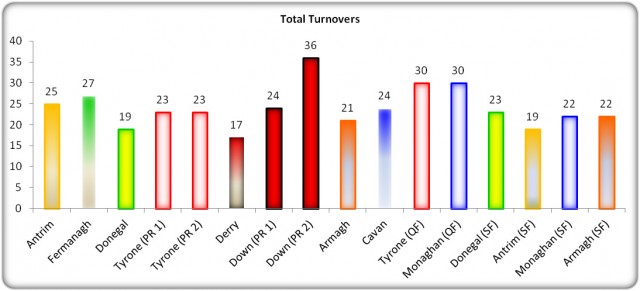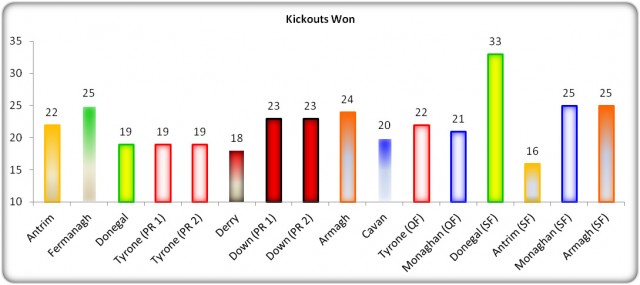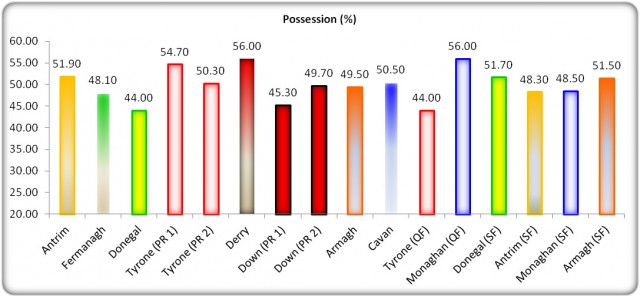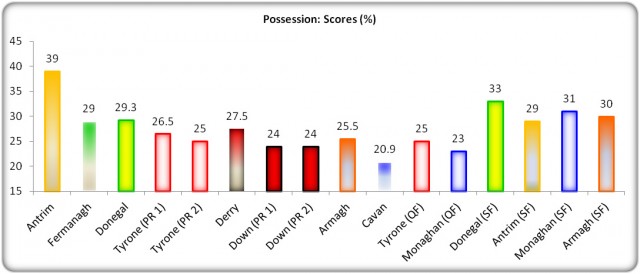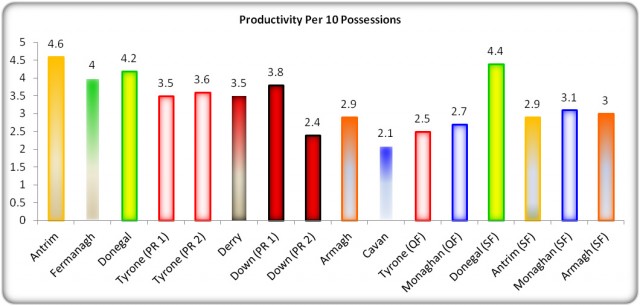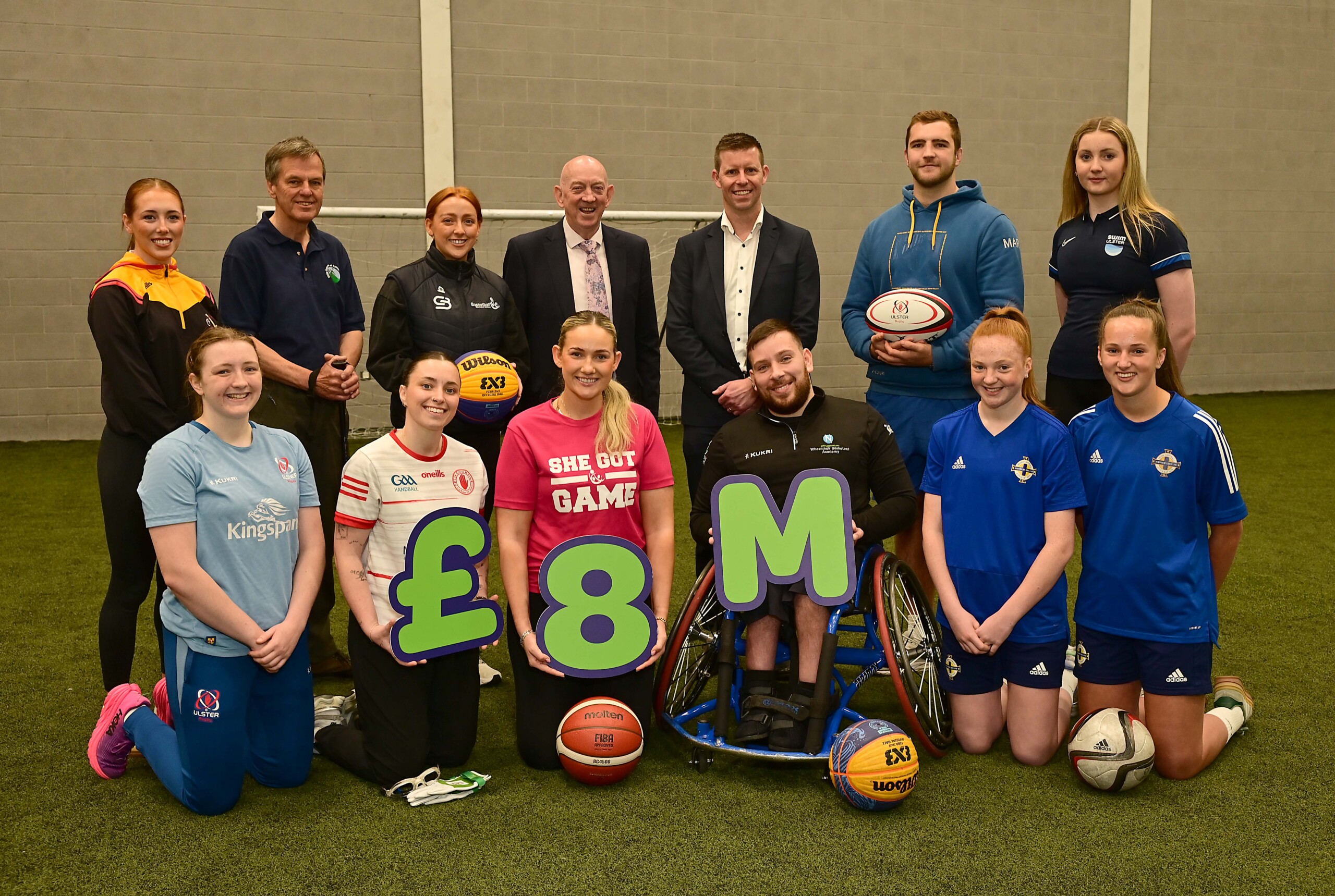Statistical Analysis of Armagh v Monaghan
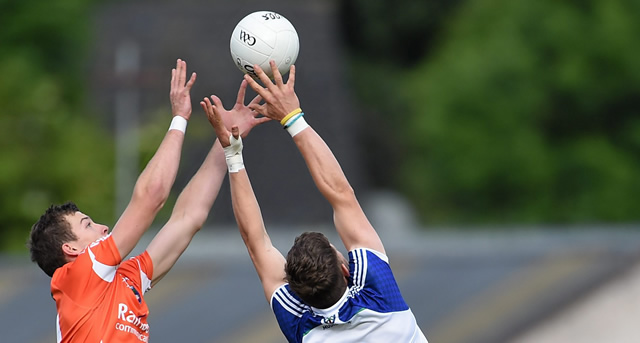
Throughout the 2014 Ulster Senior Championship, Ulster GAA will be compiling a report of the key statistics from each match. The reports will look at a range of factors contributing to game play, including possession breakdown, kick out success, possession to scores ratios and turnover stats.
The purpose of this project is to identify the key differences between team performance, and possibly help pin point where the key differences existed. Ultimately, it is hoped to identify the key area each team needs to address ahead of their next championship outing in 2014.
Time in Possession
This match provided us with the second draw of the Ulster Championship, albeit the first match with both teams delivering identical score lines, with 14 points apiece. Given the score line, it will be interesting to see if any of the other statistics point to any particular strengths or weaknesses for either team. Inevitably both teams will be eager to address their own weaknesses while exploiting those of their opponents in the replay this coming Sunday.
The possession stats are very interesting, although provide little in the way of opportunity for either team ahead of the replay. In the first half Monaghan dominated possession (58.4%), while in the second half Armagh dominated possession (61.4%). If we consider that both halves ended level, 6 points each in the first half, and 8 points each in the second, then the possession statistics are largely unimportant. Dominance of possession did not translate to the score board. However, it is important to examine in detail each team’s use of possession.
Over the course of the game Armagh spent slightly more time in possession, with this marginal advantage also evident in number of possessions. Armagh secured possession 46 times, compared to 45 for Monaghan. Taking both factors into account, Monaghan averaged 33 seconds per possession, while Armagh consumed an average of 35 seconds per possession.
Figure 1A & 1B: 1st & 2nd Half Possession
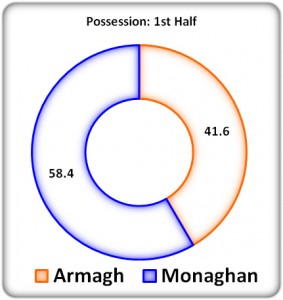
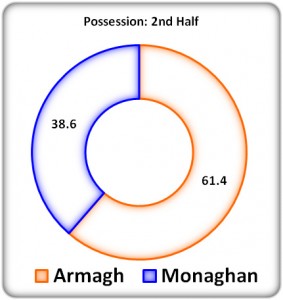
Figure 2: Full Match Possession
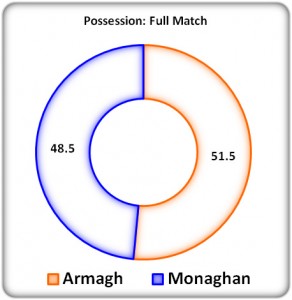
Possession to Scores Ratios
Comparing possession to scores ratios provides little more insight into any underlying difference that may have existed between the teams on Saturday evening. There were some very subtle differences where both teams had marginal advantages, however, these essentially cancelled one another out.
Monaghan were more effective at creating shooting chances from their attacks, shooting 28 times from 32 attacks, a conversion rate of 88%. Compare this to Armagh, who shot from 27 of their 34 attacks (79%). However, this advantage for Monaghan was cancelled out in both other stages of possession, with Armagh superior at generating attacks from possessions (74% compared to 71% for Monaghan), and also more accurate from shots taken, scoring from 52% of shots taken compared to Monaghan’s 50%.
To summarise, Monaghan converted 31% of possessions to scores, while Armagh converted 30%. Despite a lesser conversion rate, Armagh’s one superior possession allowed them to secure enough scores the clinch the draw.
Figure 3: Possession : Scores Ratio
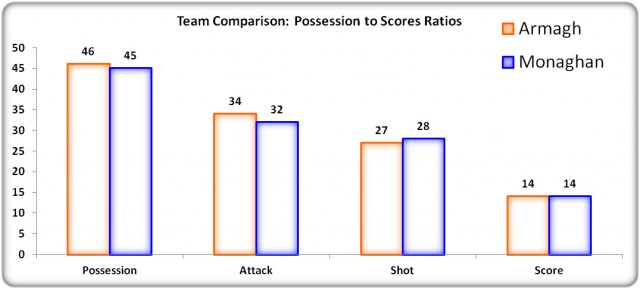
Kick Out Statistics
The balance of possession is further backed up through analysis of the kick out battle (Figure 4). This battle was evenly split in both halves of the match, with both teams securing a total of 25 possessions from kick outs. The half by half balance is all the more interesting when you consider the time spent in possession in each half. Despite Monaghan appearing dominant in the first half and Armagh in the second neither team displayed superiority from kick outs.
Figure 4: Kick Outs Won
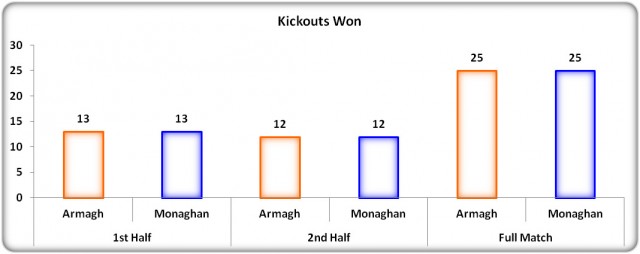
Figure 5: Kick Out Breakdown
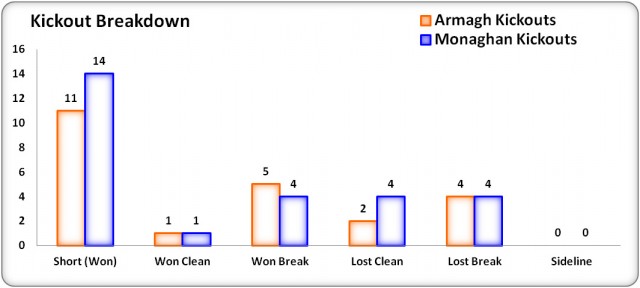
The kick out breakdown highlights how both teams appear to prefer to use the short kick option when they can. Armagh claimed 74% of their own kick outs, with Monaghan claiming 70% of their own kicks. Of the contested kick outs in the match, Armagh came out on top, winning 56%, compared to Monaghan’s 44%. This may provide a reason why Monaghan favour the short kick out option, but may also provide Armagh with a key area to target ahead of the replay. If Armagh were able to maintain this success rate and attempt to limit the number of short kick outs they allow Monaghan, they could enjoy dominance of the kick out battle and increase their overall possession share.
Turnovers
The turnover count provided yet another evenly split battle. Each team lost possession 22 times over the course of the match. These counts are in around the average per team witnessed in the Ulster Championship this year. Armagh increased their count by 1 from their quarter final versus Cavan, while Monaghan reduced their count by 8 from their quarter final against Tyrone.
When analysing the breakdown of turnovers, there is little difference, with neither team likely to be overly concerned with any of their turnover counts. Monaghan may look to the 5 turnovers through shots short and blocked and identify this as an area where they can exploit in the replay. If they had managed to score even one of these in this match they would have won the match.
Figure 6: Turnovers
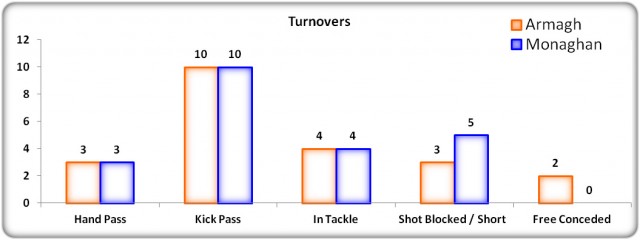
Monaghan were marginally more productive in this match, given that they had a single possession less, but scored the same number of points as Armagh (Figure 7). Neither team were able to score a goal, therefore neither were able to deliver a telling difference in their productivity. It will be interesting to see if either can score a goal in the replay. Given the closeness of this original game it is likely that a goal could well be enough to deliver a victory.
Figure 7: Productivity
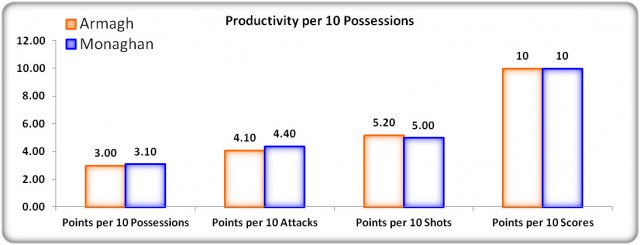
Figure 8: Shot Outcome
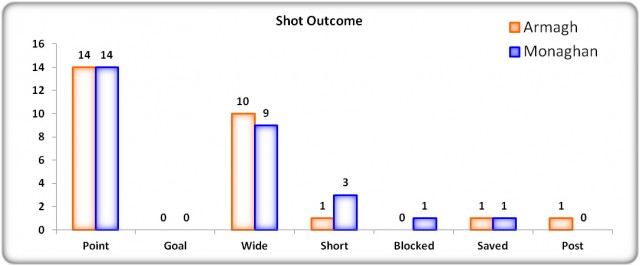
With every statistic, including the final score, being evenly balanced, both Armagh and Monaghan will be keen to examine their shooting stats in order to address any weaknesses in this facet of their game ahead of the replay. The volume of missed shooting opportunities was not particularly high for either team, with Armagh having 10 wides, to Monaghan’s 9 wides. Armagh may well feel frustrated that the one effort that rebounded off the post could have been the vital score, while Monaghan will no doubt be disappointed to have dropped 3 efforts short over the course of the game. As previously alluded to, neither team scored a goal, and neither were overly prolific in terms of creating goal chances, with each goalkeeper only being required to make one single save over the course of the match from goal bound efforts.
Summary
Obviously with this game having finished a draw it was unlikely that there were going to be any stand out underlying stats separating the teams. In fact, the stats were more close and balanced than would ever have been expected, even for a match that finished in a draw. Normally in drawn games one team will dominate in a certain area, while their opponent dominates another area, thus cancelling each other out. However, the stats in this game have highlighted how both teams delivered almost identical approaches to the game, with similar degrees of success. For both teams it will be very difficult to pinpoint a definitive area where they can hope to exploit in the replay.
Monaghan
Monaghan may identify the 3 shots that were short over the course of the game as an area to improve upon. It is likely they will target a reduction in this figure for the replay. While the total of 3 may not be overly concerning this must be taken in the context of the closeness of the result, as little as one of these making the distance could have resulted in a victory.
They will also look to their Quarter final performance against Tyrone, where they forced 30 turnovers and examine if they can increase their intensity to force more turnovers from Armagh than the 22 they forced in this match. Given both teams were equally productive with their possessions it is likely both will be keen to secure the greater share of possessions over the course of the replay. Based upon the kick out statistics there is the possibility that Monaghan may struggle to secure sufficient primary possession therefore highlighting the need to increase the volume of turnovers they force from Armagh.
Armagh
As highlighted, both teams will target increased possession. Armagh appear to have the ability to turn the screw at the kick outs, having claimed a greater share of contested kick outs. They can force this issue by attempting to limit the number of short kick outs afforded to Monaghan. Over the course of this match they allowed Monaghan 14 short kick outs. As an example, if Armagh had reduced this number to 10, and forced the 4 kick outs to be played long as contested ball, Armagh would likely have won at least 2 of these based on the statistics of this game. Overall this would have resulted in 4 greater possessions for Armagh than Monaghan. Given that both teams were equally productive these extra 4 possessions would likely have been enough for Armagh to have won this match.
USFC 2014 – Summarised
Below is a selection of key aspects of game play from the 2014 USFC. It allows for comparison between the teams that have played to date across this range of key aspects.
